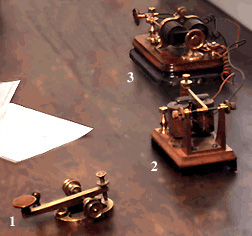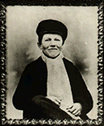
Telegraph Set at Smiths Creek Depot in Greenfield Village
1) Telegraph Key: Used by Julius McMartin to communincate with twelve year old Thomas A. Edison on a home made line between their Port Huron homes in 1859. Keys act as switches. They complete an electrical current to open and close relays at receiving stations. Longer or shorter closures produce the telegraphic code. (ca. 1859, Object ID: 60.17.1)
2) Telegraph Sounder: Used to listen to incoming coded telegraph messages. By the 1850s, telegraphers realized that they could distinguish the difference between dots and dashes in the clattering of relays. Sounders created louder sounds to make interpretation easier. (1860-1865, Object ID: 29.3092.1)
3) Telegraph Relay: Used to amplify and retransmit electrical signals that weaken over 20-30 mile spans between stations. (ca. 1865, Object ID: 96.53.1)

By the early 1860s railroads and telegraphs were closing distances and speeding communications. America was effectively becoming smaller and events more immediate. Smiths Creek Depot in Greenfield Village provides a snapshot of life in this changing world during 1862. The station bears witness to the raging civil war with its accumulation of aid packages awaiting shipment to distant soldiers. A clattering telegraph sounder and chalkboard messages about forthcoming newspaper headlines suggest people's urgent desire for the latest news from remote battlefronts. Thomas Edison, a clever 14 year old entrepreneur recognized this desire and exploited the telegraph to meet it.
 Edison, an ambitious newsboy travelling the railroad line from Detroit to Port Huron, learned on April 9, 1862 that the Detroit Free Press would carry banner headlines reporting the devastating Battle of Shiloh. Knowing that such headlines increased sales, he negotiated with a Detroit station telegrapher to transmit the news to each depot on the line, including Smiths Creek, for posting on station chalkboards. He then arranged to receive on credit five times his normal draw of newspapers. His daring plan worked. At each station crowds flocked, paying ever higher prices as his stock of 1,000 newspapers diminished. "It was then it struck me that the telegraph was just about the best thing going, for it was the notices on the bulletin board that had done the trick. I determined at once to become a telegrapher." Edison, an ambitious newsboy travelling the railroad line from Detroit to Port Huron, learned on April 9, 1862 that the Detroit Free Press would carry banner headlines reporting the devastating Battle of Shiloh. Knowing that such headlines increased sales, he negotiated with a Detroit station telegrapher to transmit the news to each depot on the line, including Smiths Creek, for posting on station chalkboards. He then arranged to receive on credit five times his normal draw of newspapers. His daring plan worked. At each station crowds flocked, paying ever higher prices as his stock of 1,000 newspapers diminished. "It was then it struck me that the telegraph was just about the best thing going, for it was the notices on the bulletin board that had done the trick. I determined at once to become a telegrapher."
Thomas Edison's Smiths Creek experience inspired him to study telegraphy and become an innovator in this high technology of the era. |

